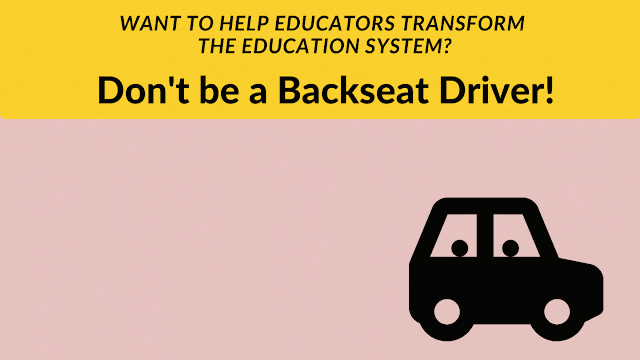Large and Small Schools: Leverage your upsides well
The idea: The size of your School/ Organisation can offer unique advantages to your strategy for creating impact.
Smaller schools can leverage quick alignment on Vision and Culture and Organisational Agility. Larger schools can leverage Institutional knowledge, Diverse/ Specialised Teams and Centralised resources for scaling impact.
Over the last decade I have had the good fortune of working as a leader in educational organisations of very different sizes. For a reference point, the smallest organisation was approximately a team of 50 serving about 100 students at a single physical location, and the largest organisation is still growing with a team of 250+ serving 5000+ students (aiming to serve 20000+) across multiple locations.
In addition to this, my opinions have been influenced by journeys along growing schools - from starting up in its initial years to a full fledged large school.
During this time, I realised that the size and scope of the organisation presents unique opportunities and challenges. I am definitely no expert but I thought it would be valuable to document my learning from personal experience to clear my own thinking and share for anyone it may be useful for.
If School leaders are aware of the potential upsides that come with large and small schools, they can be more intentional about leveraging them as they plan their strategy. Here are some advantages that small / large schools have:
1. Shared Vision and Culture
Smaller schools can leverage the advantage of quick alignment of vision and permeation of desired culture through the organisation.
A shared vision can be built faster in smaller schools because it is easier for the core leadership team to communicate and share their thinking directly with the entire team when it is smaller. Since these School leaders are usually driving the vision and strategy, they have experience and skill at inspiring through communication. Through these interactions they can also connect with team members and engage in conversations that help them understand how their particular work contributes to achieving the organisation's vision.
Similarly, creating a culture of trust, collaboration and innovation in my experience is easier to do in smaller organisations because more connectedness with members driving the culture means more direct demonstration of desired attitudes and behaviours can happen. Team members have opportunities to engage with and learn as they solve problems.
Building a shared vision and culture can be a much slower process in a larger organisation because the teams are just bigger and enabling direct connection with apex or founding leaders is harder with more people on the team. It is harder to accommodate more direct or even informal conversations with all team members to build connections and therefore permeation happens slower and is more complex in larger organisations. It is definitely achievable through flatter, distributed leadership structures and strong two-way communication, but it is surely more complex.
For example, in smaller schools our core leadership team was able to communicate the vision and strategic plan, drive professional development, facilitate professional learning communities directly with all teachers, and observe most of them in their classrooms. We were able to interview most new hires if we wanted to. When needed we could even model productive parent interactions along with teachers, and be available to problem solve at the classroom level. In a larger school context I would have loved to be able to do all this, but I can’t. We definitely need many more leaders and team members to imbibe the culture first, and then spread it through these kinds of interactions.
This is probably why we hear of so many organisations (in particular small start-ups) suffering from a ‘Vision drift’ or a ‘Culture shift’ as they grow… it gets more challenging.
2. Institutional Learning and Capacity Development
Larger schools or school networks can leverage their investment in institutionalising standards and systems for developing capacity quickly and sustaining high quality throughout the organisation.
By standards I am referring to guiding principles or frameworks that help an organisation understand the vision and mission. These may be further supported by organisational processes on how they might be applied. It helps team members identify what they are aspiring for and provides guidance on how to achieve it. But it does so without being so specific that it puts a ceiling on excellence or stifles innovation. For me, great standards ‘raise the floor’ of quality educational practices without ‘putting in a ceiling’ on it. Why are Standards + Systems valuable? If created purposefully and designed well, Standards provide a framework for making your vision more concrete. Second, education involves complex thinking and tasks so Standards + Systems help reduce cognitive overload for team members and promote use of effective practice thereby increasing efficiency. Third, if desired, Standards + Systems enable effective scaling of practices (more on this in point 4 below).
In a large organisation, investing in establishing Standards + Systems is a no brainer. These guiding principles, along with mentoring and support from leaders enable team members to learn quickly. This support is important for large teams. It makes it strategic to invest time in it. In small organisations, this is tricky. Creating Systems + Standards is time consuming and difficult to prioritise especially when leaders are wearing many hats. If you are going to have just a few people use it over the years is it really worth the effort? And as you differentiate for different roles and processes, the prospective user base gets even smaller. All this might make it hard for leaders to prioritise this important work. I know I found it difficult.
Further, larger organisations mean you have a larger sample - more teachers, more students and therefore more data points for evaluating the effectiveness of practices more reliably. Because more teachers are trying to implement practices with more students across more contexts, when the data shows you that something works you can be more confident that it was not just luck.
However, on the flip side, collecting this data in a meaningful way can also be complex.
In small organisations, while it is much easier to evaluate the effectiveness through direct observation, it is much harder to generalise whether the practice works. Because the sample of students or teachers is small, it is difficult to rule out whether it was achieved because of that particular teacher or something else unique to that specific situation.
For example, in my smaller schools, we ran foundational professional development workshops at the start of the year for new teachers. The purpose was to equip the teachers with essential foundational knowledge they would need in the school (This was a special needs school so it was focused on knowledge about development, sensory processing, explicit instruction etc. knowledge that we did not expect teachers to necessarily come in with). Because the leaders were driving many things and because we had a handful of new teachers every year, conducting it ourselves each year felt like a more feasible option. In contrast, in my larger school - which had schools at different locations, I felt the need to turn this key foundational knowledge into digital self-paced courses from the get go, because it was impossible to do this effectively for so many new teachers in so many locations. 2 years after investing in this, I do feel that the effort was worth it. New teachers are able to use it to get better faster, and experienced teachers use it to push the boundaries of other proficient teaching. No doubt, it is hard work and would have been impossible without a very capable and collaborative leadership team that I am fortunate to have.
Smaller schools can leverage their smaller team size to allow more Customised pathways for teachers and students
Learning pathways for teachers can be customised more easily in smaller schools. Because the team sizes are smaller, it is easier to evaluate situations on a case by case basis and make the best decision. In larger schools, while you may want to do this, it is often not feasible to evaluate situations or individual requests on a case by case basis and therefore more policy is required for fairness. Strong distributed leadership systems can enable more decentralised decision making and reduce the downsides of a one-size-fits-all approach but it is still more challenging with a larger team size!
3. Innovation
Smaller schools have the advantage of being more agile i.e. they can move quickly from idea to implementation. Also decision-making and problem solving during the implementation process is easier with smaller teams.
Quick decision making, implementation and course correction takes more time in large organisations. A new innovation is more easily piloted in a smaller school because alignment, communication and planning around the project can happen quickly with small teams. Collaboration and coordination can be more complex with larger, more specialised teams. Also, larger, diverse teams means less people across the organisation know each other well and can build connectedness. Strong interpersonal connectedness creates lots of potential for collaboration. Simply put, it is usually easier to collaborate with some you are more familiar with.Also, more institutionalisation and systems level processes have the potential to slow down decision making in large schools. Implementation can also be more complex because of the number of people involved… This is the downside of specialisation.
Larger organisations have the diversity advantage i.e. they are more likely to have more diverse teams who can bring in specialised expertise and different viewpoints into the innovation process.
Larger Schools allow for more specialised hiring and roles across the organisation. While this could mean there is risk of teams working in silos, if the conditions of collaboration and learning are set up well, diverse ideas can come together to create new things. Smaller organisations typically cannot afford to have as much diversity or expertise on the team and tend to have fewer team members who wear many different hats in the organisation.
4. Scaling Impact
Larger organisations can leverage their institutionalised knowledge, their human and economic resource capital to scale impact by generating both theoretical learning and learning around implementation using their own school(s) as learning sites.
Firstly, because in large schools (or networks of schools) there already exists a need to institutionalise learning - knowledge and processes are already captured in a way that is scalable, larger schools have an advantage. Also, because economies of scale kick in there is more potential for self-sufficient scaling and more affordable fees.
Secondly, in Education, a lot about what should be done is communicated in theory and policy but much fewer models of implementation exist. Educators also refer to this as the ‘Knowing-Doing Gap’. Large Schools or organisations have an advantage because they can actually implement many of the practices in their own schools with the conditions required for scaling. Therefore more learning around implementation can happen which in turn can lead to more successful transfer to other settings at scale.
In comparison, in smaller schools scaling of impact can typically be done by sharing knowledge and research - which is important too, but it is harder to address the ‘knowing-doing gap’.
These ideas are fairly established in the business space. Personally, I found them to hold true in Schools as well so School leaders might consider how they can leverage these for higher impact strategies.
.png)




Comments
Post a Comment